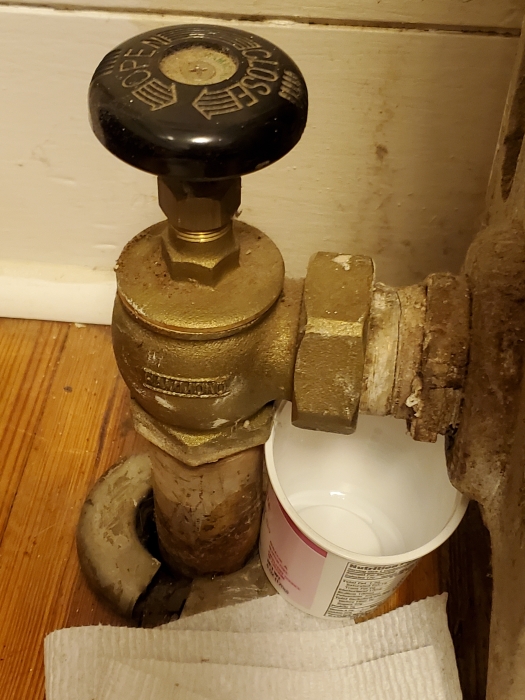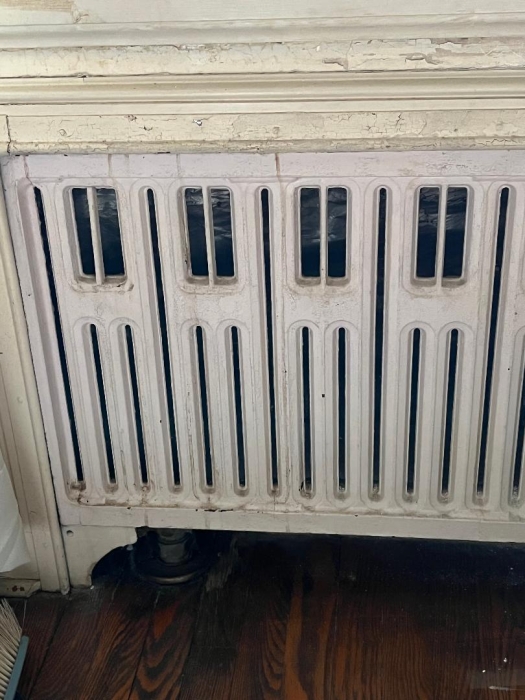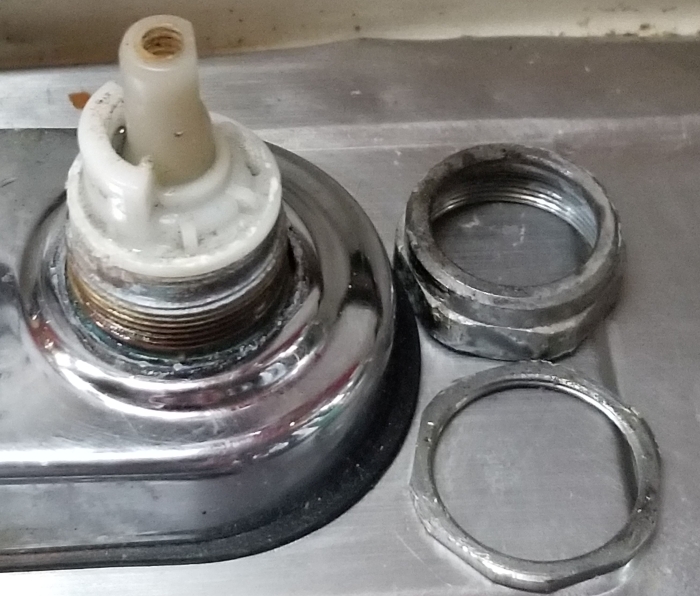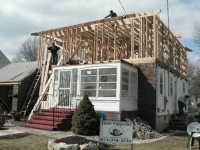Ask Me Anything • Licensed Master Plumber
Have an annoying, potentially damaging drip at radiator-valve connection. Should I try to tighten? Which way? Or call a plumber to be safe?
Sailorthom said:
Have an annoying, potentially damaging drip at radiator-valve connection. Should I try to tighten? Which way? Or call a plumber to be safe?
Put the wrench below on the brass nut, tighten upwards.
Generally speaking, is a heat pump heating system replacing a hot water heating system currently in place a good plan for a local NJ house? We are thinking about replacing an old hot water system that uses radiators with a new modern heat pump system I have read that in the freezing temperatures that we get in NJ that the heat pump system does not provide enough heat and supplemental heating is needed.
Jaytee said:
Sailorthom said:
Have an annoying, potentially damaging drip at radiator-valve connection. Should I try to tighten? Which way? Or call a plumber to be safe?
Put the wrench below on the brass nut, tighten upwards.
Did that work?
RobertRoe said:
Generally speaking, is a heat pump heating system replacing a hot water heating system currently in place a good plan for a local NJ house? We are thinking about replacing an old hot water system that uses radiators with a new modern heat pump system I have read that in the freezing temperatures that we get in NJ that the heat pump system does not provide enough heat and supplemental heating is needed.
My experience is that the technology to heat efficiently in low temperatures is not quite in place yet. However, there is something called "hyper heat" that is supposed to make that no longer the case. The truth is I don't know enough about it except to stay that the equipment is expensive and any home I've seen it installed in does in fact have have a boiler as supplemental heat.
Replacing a steam radiator shut-off valve is what I would call an advanced DIY project. You need some specialized tools like a spud wrench and there are things that can go wrong when you try to remove the old valve. When a valve has been screwed onto an iron pipe for 30 years, it usually doesn't come off easily. Watch a YouTube video on removing the old shut-off valve and then decide if you want to hire a plumber.
Sailorthom said:
Did not budge.
I’ve had good luck with a large pipe wrench - like 24”, and using a length of iron pipe to add additional leverage.
Rather than just tighten it, I’d loosen completely and add some pipe dope or yellow teflon tape to the threads and then re-tighten.
We have had french drains and a sump pit with pump to the outside for years in our basement, as do most of our neighbors, since our a block has a lot of underground water even without heavy storms. The french drains are along the interior perimeter walls and direct the water to the sump pits, keeping the floor dry. The french drains were added when we moved into the house over 25 years ago. Over that time, as long as the pump has been able to run, our basement has stayed dry. But if the pump failed for some reason (loss of power or mechanical failure), we could get several inches of water pretty quickly so we don't keep anything vulnerable right on the floor. Recently we did a major renovation and when they bumped out our kitchen it included full basement underneath the addition, where another sump pit was added and interconnected with the existing french drains. They also installed exterior footing drains on the excavated portion of the rear and side of the house which were already where our worst water incursions occur. Our property is elevated enough that the footing drains work via gravity rather than needing a pump. I think those exterior drains are what really saved us during Ida. We did not lose power so the sump pumps were able to run, but we did not hear them running constantly as we might have expected otherwise. Since Sandy, we also have a moderate size gasoline powered generator (and the electrical subpanel/switch setup to power selected priority circuits in the house) and we keep a spare sump pump on hand. (The Home Depot/Lowes sump pump shelves are usually empty during bad storms.) So we rely on multiple layers of protection that have mostly served us well.
We have a Colonial-style home in Maplewood, built in the late 1920s-early 1930s. The radiators are set into the walls (system runs off a boiler). Under one of the radiators we keep finding some powdery white dust (I grew up in an old house in Brooklyn and Dad used to call this stuff "calsomine/kalsomine") - we don't know why this keeps showing up under this radiator. We also have seen some yellow jackets in this room, and they seem to be around the window over the powdery dust. Have not seen any flying around the outside of the window and the exterminator has come and inspected that area and hasn't seen them, either.
We've been looking at the area on the inside of the wall closely and it seems as if there is a thin piece of sheet metal behind the radiator and against the inside of the outer wall. It is loose. We can't get to it to put it back into place because the radiator is there. I've added a picture of the radiator.
My question is, who do we contact to move the radiator and reaffix the metal sheeting? We think that might be how the yellow jackets are getting in, even though we don't see any when we shine flashlights into the radiator. A plumber? contractor? handyman? The radiator and the metal frame around it has been painted over so many times that just getting to the area will be a headache.
Help??? Thanks for any info or suggestions as to who would be able to help us fix this.
RobertRoe said:
Generally speaking, is a heat pump heating system replacing a hot water heating system currently in place a good plan for a local NJ house? We are thinking about replacing an old hot water system that uses radiators with a new modern heat pump system I have read that in the freezing temperatures that we get in NJ that the heat pump system does not provide enough heat and supplemental heating is needed.
I think you're looking for a 2 stage thermostat. A friend bought an ecobee to control the same type of setup you're thinking about and says after setting it up, it worked well. The most difficult part was finding out the outdoor temp where it was more efficient to run the boiler than the heat pump. That all depends on the energy efficiency of the specific heat pump at different outside temp, the price of electricity, and the price of your other fuel.
Komarovsky said:
RobertRoe said:
Generally speaking, is a heat pump heating system replacing a hot water heating system currently in place a good plan for a local NJ house? We are thinking about replacing an old hot water system that uses radiators with a new modern heat pump system I have read that in the freezing temperatures that we get in NJ that the heat pump system does not provide enough heat and supplemental heating is needed.
I think you're looking for a 2 stage thermostat. A friend bought an ecobee to control the same type of setup you're thinking about and says after setting it up, it worked well. The most difficult part was finding out the outdoor temp where it was more efficient to run the boiler than the heat pump. That all depends on the energy efficiency of the specific heat pump at different outside temp, the price of electricity, and the price of your other fuel.
The industry generally calls it 40°F.
So, what are your thoughts on trying harder, trying to loosen then seal threads, or calling a plumber? The valve is probably about 10 years old but the spud looks old. It appears I have one of the most expensive plumbers on the block and have tried several over the 20ish years in Maplewood.
Sailorthom said:
So, what are your thoughts on trying harder, trying to loosen then seal threads, or calling a plumber? The valve is probably about 10 years old but the spud looks old. It appears I have one of the most expensive plumbers on the block and have tried several over the 20ish years in Maplewood.
That valve is going to have to be cut off the pipe it's screwed onto from the floor, then the spud will have to be cut out of the radiator. If the person doing the cutting screws up and cuts either the pipe or the radiator too deeply you'll be in a world of expensive trouble. Having a plumber replace that valve using a saw, chisel and wrenches should cost you around $300 to do it right. Your call.
master_plvmber said:
Komarovsky said:
RobertRoe said:
Generally speaking, is a heat pump heating system replacing a hot water heating system currently in place a good plan for a local NJ house? We are thinking about replacing an old hot water system that uses radiators with a new modern heat pump system I have read that in the freezing temperatures that we get in NJ that the heat pump system does not provide enough heat and supplemental heating is needed.
I think you're looking for a 2 stage thermostat. A friend bought an ecobee to control the same type of setup you're thinking about and says after setting it up, it worked well. The most difficult part was finding out the outdoor temp where it was more efficient to run the boiler than the heat pump. That all depends on the energy efficiency of the specific heat pump at different outside temp, the price of electricity, and the price of your other fuel.
The industry generally calls it 40°F.
That's good to know, thank you for this. I'll have to ask my friend how close to that number he ended up at, and if he's got a "hyper heat" setup you mentioned.
I've got a leaky kitchen faucet. When I tried to remove the valve stem (is that the right term) , I couldn't figure out how to do it.
As you can see from the pic, there were two nuts on the stem, which I removed. But now I'm not sure what to do next. At first I thought I could unscrew the whole thing, but there's no place to grab a wrench on to. Now I'm thinking that just the plastic piece comes out? Maybe?
Anyway, I'm stumped. Never saw one like this before.
master_plvmber said:
Avoid Home Depot and Lowes versions of any high end faucet. The manufacturers make lesser quality versions of fixtures to be sold exclusively in stores of this type.
Where do you buy instead -- directly from the manufacturer? Also for tools etc in general. Recently (finally!) got our own place, and want to see how much I can learn to fix and do myself.
drummerboy said:
I've got a leaky kitchen faucet. When I tried to remove the valve stem (is that the right term) , I couldn't figure out how to do it.
As you can see from the pic, there were two nuts on the stem, which I removed. But now I'm not sure what to do next. At first I thought I could unscrew the whole thing, but there's no place to grab a wrench on to. Now I'm thinking that just the plastic piece comes out? Maybe?
Anyway, I'm stumped. Never saw one like this before.
The plastic piece lifts out. It frequently takes great effort, and you my break it in the process, but that's what's gotta happen. This is why a lot of plumbers tell clients to just buy a new faucet.
PVW said:
master_plvmber said:
Avoid Home Depot and Lowes versions of any high end faucet. The manufacturers make lesser quality versions of fixtures to be sold exclusively in stores of this type.Where do you buy instead -- directly from the manufacturer? Also for tools etc in general. Recently (finally!) got our own place, and want to see how much I can learn to fix and do myself.
Go to a plumbing wholesaler like Ferguson or General Plumbing Supply. You might pay a little more than me. Like 2% at most. But you'll get the right product.
PVW said:
master_plvmber said:
Avoid Home Depot and Lowes versions of any high end faucet. The manufacturers make lesser quality versions of fixtures to be sold exclusively in stores of this type.Where do you buy instead -- directly from the manufacturer? Also for tools etc in general. Recently (finally!) got our own place, and want to see how much I can learn to fix and do myself.
Try a local plumbing supply store.
master_plvmber said:
drummerboy said:
I've got a leaky kitchen faucet. When I tried to remove the valve stem (is that the right term) , I couldn't figure out how to do it.
As you can see from the pic, there were two nuts on the stem, which I removed. But now I'm not sure what to do next. At first I thought I could unscrew the whole thing, but there's no place to grab a wrench on to. Now I'm thinking that just the plastic piece comes out? Maybe?
Anyway, I'm stumped. Never saw one like this before.
The plastic piece lifts out. It frequently takes great effort, and you my break it in the process, but that's what's gotta happen. This is why a lot of plumbers tell clients to just buy a new faucet.
Thanks. Problem is that I'm in an apartment, and maintenance already told me the leak isn't big enough for them to bother with. Unlikely they'll go for a new faucet. And I'm not one to make a stink about relatively small problems.
I'll see if I can pull it out. Just straight up?
drummerboy said:
Thanks. Problem is that I'm in an apartment, and maintenance already told me the leak isn't big enough for them to bother with. Unlikely they'll go for a new faucet. And I'm not one to make a stink about relatively small problems.
I'll see if I can pull it out. Just straight up?
yes straight up. Grab the plastic stem with a pliers and yank it up.
So what keeps it secure? Just friction?
Jaytee said:
yes straight up. Grab the plastic stem with a pliers and yank it up.
PVW said:master_plvmber said:
Avoid Home Depot and Lowes versions of any high end faucet. The manufacturers make lesser quality versions of fixtures to be sold exclusively in stores of this type.Where do you buy instead -- directly from the manufacturer? Also for tools etc in general. Recently (finally!) got our own place, and want to see how much I can learn to fix and do myself.
master_plvmber said:
Go to a plumbing wholesaler like Ferguson or General Plumbing Supply. You might pay a little more than me. Like 2% at most. But you'll get the right product.
drummerboy said:
Try a local plumbing supply store.
Thanks! Are there similar stores for other domains -- eg carpentry, electric, gardening? Well, I have been to a few garden stores in the area but never been super impressed. Some of this stuff feels like I should be able to find used too -- eg I don't need brand new garden shears, a used set that does the job would work. Same for, say, garbage bins for the garage. I keep ending up at Home Depot because it's easy and convenient, but feels like I'm probably missing out on some options.
There are electrical supply stores, but for carpentry and gardening tools you're probably better off with a big box store.
I love talking about plumbing. Thanks so much to Master Plumber. On Newark Way, there is a good electric supply and also a good plumbing supply business. Off of High St. in Orange, there is an excellent garden supply. On Park Ave. in Orange, there is a real good lumber supply business.
drummerboy said:
So what keeps it secure? Just friction?
Jaytee said:
yes straight up. Grab the plastic stem with a pliers and yank it up.
Sometimes you can also work a thin screwdriver between that white plastic and the steel it rests on to twist and start to pry it up.
BTW: First have the drain covered or closed so that those pesky little parts (spring and rubber bits) don't drop into the sink trap. -Also note/remember how all the parts are placed/fit together -particularly the little spring and rubber bit that fit into the hole under the stem valve (on some types) which can be coaxed out with a small regular screwdriver.
Rentals
-
Huge Brand New construction Apartment in 2 family home with 4 bedrooms 3 bathrooms
4 Bd | 3Full Ba
$4,500
Sponsored Business
Promote your business here - Businesses get highlighted throughout the site and you can add a deal.
























Adjust/close slightly the fill valve that brings water into the toilet tank. It could be that your house has high water pressure that makes noise through the flush cycle.